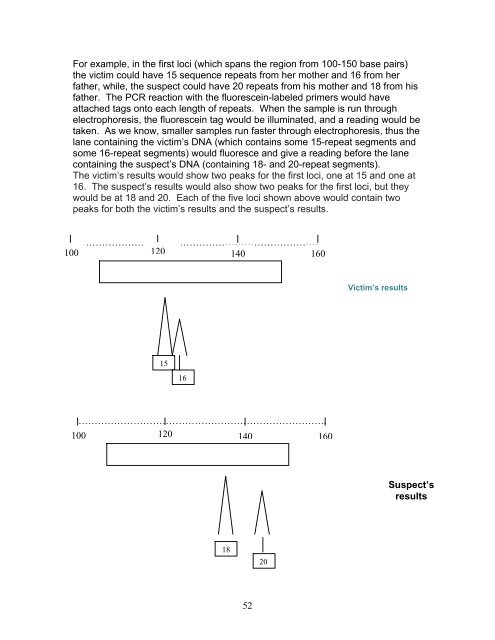Investigating CSI – Background material Table of Contents I ...
Investigating CSI – Background material Table of Contents I ...
Investigating CSI – Background material Table of Contents I ...
You also want an ePaper? Increase the reach of your titles
YUMPU automatically turns print PDFs into web optimized ePapers that Google loves.
For example, in the first loci (which spans the region from 100-150 base pairs)<br />
the victim could have 15 sequence repeats from her mother and 16 from her<br />
father, while, the suspect could have 20 repeats from his mother and 18 from his<br />
father. The PCR reaction with the fluorescein-labeled primers would have<br />
attached tags onto each length <strong>of</strong> repeats. When the sample is run through<br />
electrophoresis, the fluorescein tag would be illuminated, and a reading would be<br />
taken. As we know, smaller samples run faster through electrophoresis, thus the<br />
lane containing the victim’s DNA (which contains some 15-repeat segments and<br />
some 16-repeat segments) would fluoresce and give a reading before the lane<br />
containing the suspect’s DNA (containing 18- and 20-repeat segments).<br />
The victim’s results would show two peaks for the first loci, one at 15 and one at<br />
16. The suspect’s results would also show two peaks for the first loci, but they<br />
would be at 18 and 20. Each <strong>of</strong> the five loci shown above would contain two<br />
peaks for both the victim’s results and the suspect’s results.<br />
………………………………………………………………….<br />
100 120 140 160<br />
15<br />
16<br />
…………………………………………………………………..<br />
100 120 140 160<br />
18<br />
52<br />
20<br />
Victim’s results<br />
Suspect’s<br />
results


